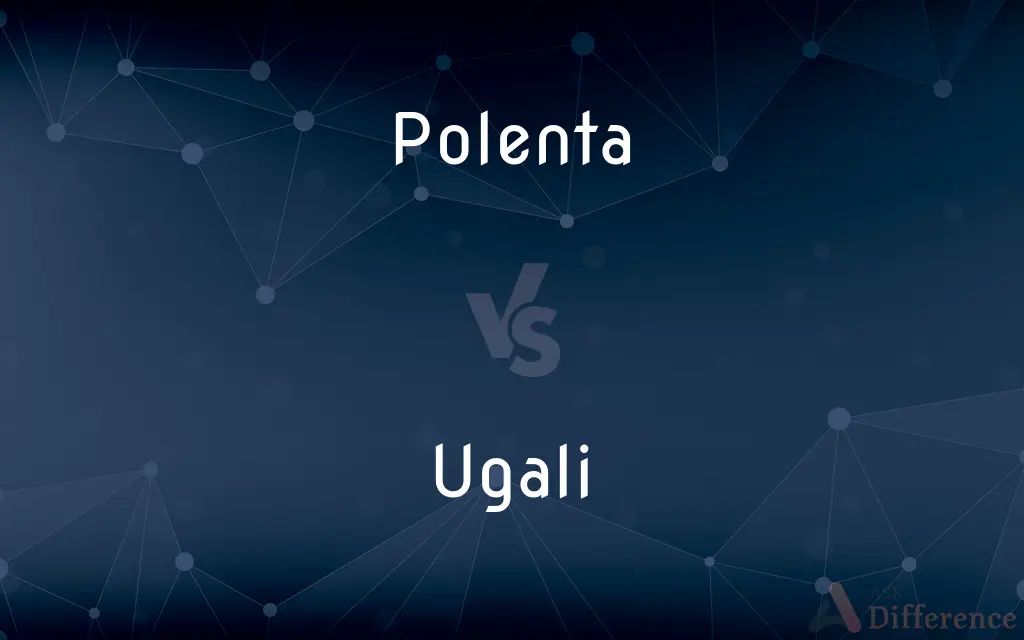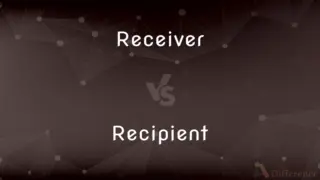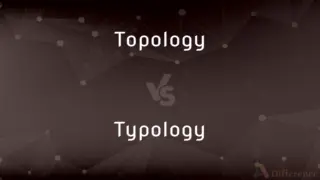Polenta vs. Ugali — What's the Difference?
Edited by Tayyaba Rehman — By Maham Liaqat — Updated on April 3, 2024
Polenta, a North Italian staple, is coarse cornmeal porridge, often creamy or set; Ugali, East African cuisine's cornerstone, is a stiffer cornmeal cake, less seasoned, reflecting diverse culinary traditions.

Difference Between Polenta and Ugali
Table of Contents
ADVERTISEMENT
Key Differences
Polenta originates from Northern Italy and is traditionally made from yellow corn, giving it a rich, buttery flavor often enhanced with cheese, butter, or cream. It can be served creamy or allowed to set and then grilled, fried, or baked. Ugali, on the other hand, hails from East Africa and is a staple food made primarily from white cornmeal. It is cooked to a firmer consistency and typically served as a side, eaten with hands, and used to scoop up meat, vegetables, or sauce.
The preparation of polenta involves stirring cornmeal into boiling water or broth until thick and creamy, allowing for a range of consistencies from soft to firm, depending on preference. Ugali requires a simpler method, where cornmeal is added to boiling water and stirred until it forms a dense block that holds its shape, emphasizing its role as an accompaniment rather than a standalone dish.
Polenta's flavor profile is versatile, often enriched with other ingredients to enhance its taste and texture, making it a suitable base for a variety of dishes in Italian cuisine. Ugali, while plainer in comparison, prides itself on its ability to complement the flavors of the dishes it is served with, acting as a subtle backdrop to bolder tastes.
In terms of cultural significance, polenta once symbolized peasant food but has been elevated to gourmet status in many parts of the world, featured in upscale restaurants. Ugali remains a symbol of sustenance and tradition in East African communities, representing a shared culinary heritage that unites various cultures across the region.
The nutritional content of both dishes is relatively similar, providing a good source of carbohydrates and fiber. However, polenta, especially when enriched with butter, cheese, or cream, can be higher in calories and fat, whereas ugali tends to be lower in fat and calories, making it a staple in more diet-conscious meals.
ADVERTISEMENT
Comparison Chart
Origin
Northern Italy
East Africa
Base Ingredient
Yellow cornmeal
White cornmeal
Consistency
Creamy to firm
Firm to very firm
Serving Style
Can be creamy, grilled, fried, or baked
Served in a dense block or cake
Flavor Profile
Rich and versatile, often seasoned
Plain, complements other dishes
Cultural Significance
From peasant food to gourmet cuisine
Sustenance and tradition
Nutritional Content
Higher in calories and fat when enriched
Lower in fat and calories
Compare with Definitions
Polenta
A traditional Italian dish made from cornmeal, cooked into a thick porridge.
For dinner, she served a creamy polenta topped with mushroom ragout.
Ugali
A staple food in East Africa made from white cornmeal and water.
Ugali, served with sukuma wiki, is a common Kenyan meal.
Polenta
Often enriched with ingredients like butter, cheese, or cream for added flavor.
The polenta was enriched with Parmesan, making it irresistibly creamy.
Ugali
Serves as a staple accompaniment to meats, vegetables, and sauces.
The dinner spread included a large, round block of ugali in the center.
Polenta
Can be cooled and shaped, then grilled, fried, or baked.
He grilled slices of polenta as a base for the grilled vegetables.
Ugali
Cooked to a firm consistency, often eaten with hands.
They tore off pieces of ugali to scoop up the spicy chicken stew.
Polenta
A versatile base for various toppings and sauces.
They enjoyed the polenta with a hearty beef stew poured over it.
Ugali
Known for its simplicity and ability to complement other dishes.
The plain taste of ugali perfectly balanced the spicy fish curry.
Polenta
Reflects Italy's culinary evolution from peasant food to gourmet dining.
The restaurant's polenta dish, a nod to rustic Italian roots, was a hit among diners.
Ugali
A symbol of East African culture and cuisine.
At the cultural festival, ugali was featured to represent East African culinary traditions.
Polenta
Polenta (, Italian: [poˈlɛnta]) is a dish of boiled cornmeal that was historically made from other grains. It may be served as a hot porridge, or it may be allowed to cool and solidify into a loaf that can be baked, fried, or grilled.
Ugali
Ugali, or nsima, is a type of stiff maize flour porridge made in Africa. It is also known as vuswa, bogobe, fufu, gauli, gima, isitshwala, kimnyet, kuon, mieliepap, ngima, nshima, obokima, obuchima, obusuma, oshifima, oruhere, pap, phutu, posho, sadza, ubugali, umutsima, obusuma other names.
Polenta
Maize flour as used in Italian cooking; cornmeal
Maize is used, more coarsely ground, in Italy's versatile polenta
Ugali
African cornmeal porridge
Polenta
A thick mush made of boiled cornmeal.
Polenta
Any of various types and consistencies of a starchy accompaniment to a meal made from coarse maize-meal porridge, sometimes fried or grilled.
Polenta
Pudding made of Indian meal; also, porridge made of chestnut meal.
Polenta
A thick mush made of cornmeal boiled in stock or water
Common Curiosities
What is the main ingredient in polenta and ugali?
Polenta is made from yellow cornmeal, while ugali is made from white cornmeal.
How are polenta and ugali served?
Polenta can be served creamy or set and then grilled, fried, or baked. Ugali is served in a firm block or cake.
What dishes complement polenta and ugali?
Polenta pairs well with rich sauces and meats. Ugali complements meat, vegetables, and spicy dishes.
How do the origins of polenta and ugali differ?
Polenta originates from Northern Italy, while ugali is a staple in East African cuisine.
Are there different types of cornmeal used for polenta and ugali?
Yes, polenta is usually made with yellow cornmeal, and ugali with white cornmeal.
How do polenta and ugali reflect their respective culinary traditions?
Polenta showcases Italian culinary innovation and versatility, while ugali embodies the simplicity and communal eating traditions of East African cultures.
Can polenta and ugali be considered healthy?
Both can be part of a healthy diet. Polenta, when enriched, is higher in calories and fat, whereas ugali is generally lower in both.
Can polenta and ugali be used interchangeably in recipes?
While they can substitute for each other in some recipes, their different flavors and textures may alter the dish's intended taste.
What is the texture of polenta compared to ugali?
Polenta's texture ranges from creamy to firm, while ugali is firmer and more compact.
What is the cultural significance of polenta and ugali?
Polenta has evolved from peasant food to gourmet cuisine, whereas ugali remains a symbol of sustenance and tradition in East Africa.
Is there a difference in the preparation of polenta and ugali?
Yes, polenta is cooked to a range of consistencies and often enriched, while ugali is cooked to a firm consistency without added flavors.
Can polenta be a part of a gluten-free diet?
Yes, polenta is naturally gluten-free, making it a suitable option for those avoiding gluten.
How does the flavor of polenta compare to ugali?
Polenta has a richer flavor, often enhanced with other ingredients, whereas ugali has a plainer taste, serving as a backdrop to other dishes.
Is polenta or ugali more nutritious?
Both provide carbohydrates and fiber, but polenta can be higher in fat and calories depending on added ingredients.
How do polenta and ugali fit into the culinary landscape today?
Polenta is celebrated in various cuisines for its versatility, while ugali remains a staple in East Africa, symbolizing cultural identity and tradition.
Share Your Discovery

Previous Comparison
Receiver vs. Recipient
Next Comparison
Topology vs. TypologyAuthor Spotlight
Written by
Maham LiaqatEdited by
Tayyaba RehmanTayyaba Rehman is a distinguished writer, currently serving as a primary contributor to askdifference.com. As a researcher in semantics and etymology, Tayyaba's passion for the complexity of languages and their distinctions has found a perfect home on the platform. Tayyaba delves into the intricacies of language, distinguishing between commonly confused words and phrases, thereby providing clarity for readers worldwide.
















































